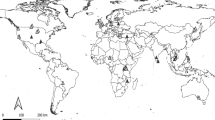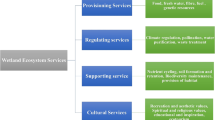Abstract
Climate change will cause major changes in ecosystems. Therefore, it is crucial that climate change policy consider the value of all services that are provided by watershed ecosystems. For this purpose, geospatial data and economic analysis are combined to determine a monetary value for wetland ecosystem goods and services (EGSs) in the watersheds of the Yamaska and Bécancour Rivers (Quebec, Canada). From published studies of wetland economic evaluations, we selected 51 relevant studies from 21 countries and performed a benefit transfer using meta-analysis. Our research emphasises the importance of considering multiple wetland characteristics when conducting a benefit transfer because of their complementary effects. We propose an approach that integrates spatial variables that have not been previously used, including type of wetland (complex or isolated) and land use (% of agricultural, urban, forest and water land cover), at a much finer geographical scale of 50 km2. Simultaneous use of detailed spatial and economic characteristics in each wetland area allowed us to assign heterogeneous EGS values and map these values in sub-watersheds (50 km2) of the two rivers. Our results demonstrate that location and scale can affect wetland value. When wetland valuation was conducted based on mean values for geospatial characteristics, the EGS [2014 purchasing power parity (PPP) price] that is provided by wetlands was $5277 PPP/ha/year for the Yamaska River Watershed (YRW) and $3979 PPP/ha/year for the Bécancour River Watershed (BRW). When wetland valuation was performed at a more detailed sub-watershed scale to reflect variability within a watershed, EGS (2014 PPP price) that is provided by wetlands was valued higher at $9080/ha/year for YRW and $4702/ha/year (2014 PPP price) for BRW.



Similar content being viewed by others
Notes
Non-use values refer to values that have no connection with the use of the good in the present or in the future. We can distinguish three types of non-use values: existence values, which reflect the utility of knowing that certain services exist; bequest values, which reflect the utility preserved for future generations; and option values, which reflect the premium that a consumer is willing to pay to maintain the potential use of a good at a later date.
References
Bateman IJ, Mace GM, Fezzi C, Atkinson G, Turner K (2011) Economic analysis for ecosystem service assessments. Environ Resour Econ 48:177–218
Brander LM, Florax RJGM, Vermaat JE (2006) The empirics of wetland valuation: a comprehensive summary and a meta-analysis of the literature. Environ Resour Econ 33(2):223–250
Brander LM, Bräuer I, Gerdes H et al (2012a) Using meta-analysis and GIS for value transfer and scaling up: valuing climate change induced losses of European wetlands. Environ Resour Econ 52(3):395–413
Brander LM, Wagtendonk AJ, Hussain S, McVittie A, Verburg PH, de Groot RS, van der Ploeg S (2012b) Ecosystem service values for mangroves in Southeast Asia: a meta-analysis and value transfer application. Ecosyst Serv 1(1):62–69
Brouwer R (2009) Multi-attribute choice modelling of Austrialia’s rivers and wetlands: a meta-analysis of ten years of research. CSIRO working paper series: 2009-05
Brouwer R, Langford IH, Bateman IJ, Turner RK (1999) A meta-analysis of wetland contingent valuation studies. Reg Environ Change 1(1):47–57
Canards Illimités Canada (CIC, 2006) Portrait des milieux humides et de leurs terres hautes adjacentes de la région administrative de la Montérégie. Canards Illimités Canada, La société de conservation. http://www.canards.ca/province/qc/plansreg/pdf/r16txtv1.pdf. Accessed 17 Nov 2012
Cedfeldt PT, Watzin MC, Richardson BD (2000) Using GIS to identify functionally significant wetlands in the Northeastern United States. Environ Manag 26(1):13–24
Comité de gestion du bassin versant de la rivière Yamaska (COGEBY, 2010) Portrait du bassin versant de la rivière Yamaska. Yamaska/Organisme de bassin versant de la Yamaska. http://www.obv-yamaska.qc.ca/analyse-du-bassin-versant. Accessed 18 Nov 2012
Desaigues B, Point P (1993) Économie du Patrimoine Naturel. La valorisation des bénéfices de protection de l’environnement. Economica, Paris, 317 p
Eigenbrod F, Armsworth PR, Anderson BJ, Heinemeyer A, Gillings S, Roy DB, Thomas CD, Gaston KJ (2010) The impact of proxy-based methods on mapping the distribution of ecosystem services. J Appl Ecol 47(2):377–385
Fournier R, Poulin M, Revéret JP, Rousseau A, Théau J (2013) Outils d’analyses hydrologique, économique et spatiale des services écologiques procurés par les milieux humides des basses terres du Saint- Laurent : adaptations aux changements climatiques. OURANOS, Montréal
Genty A (2005) Du concept à la fiabilité de la méthode du transfert en économie de l’environnement : un état de l’art. Cah d’écon sociol rurales 77:5–32
Ghermandi A, Van Den Bergh JCJM, Brander LM, De Groot HLF, Nunes PALD (2010) Values of natural and human-made wetlands: a meta-analysis. Water Resour Res 46:W12516. doi:10.1029/2010WR009071
Haluza-Delay R, Kowalsky N, Parkins J (2009) How Canadians value nature: a strategic and conceptual review of literature and research. CSOP Research and Consulting, Edmonton. Report for Environment Canada. biodivcanada.ca. http://www.biodivcanada.ca/54B96EDA-BA11-422A-9EBB-985ADE9E0861/canval_e.pdf. Accessed 5 Oct 2012
Hanemann WM (1991) Willingness to pay and willingness to accept: how much can they differ? Am Econ Rev 81(3):635–647
Harrison GW, Rutström EE (2008) Experimental evidence on the existence of hypothetical bias in value elicitation methods. In: Plott CR, Smit VL (ed) Handbook of experimental economics results. North Holland, New York, pp 752–767
Heston A, Summers R, Aten B (2012) Penn World Table Version 7.1. Center for International Comparisons of Production, Income and Prices at the University of Pennsylvania, Philadelphia. https://pwt.sas.upenn.edu/php_site/pwt_index.php
Hoehn JP (2006) Methods to address selection effects in the meta regression and transfer of ecosystem values. Ecol Econ 60(2):389–398
Huber PJ (1967) The behavior of maximum likelihood estimates under nonstandard conditions. In: Proceedings of the fifth Berkeley symposium on mathematical statistics and probability, vol 1. University of California Press, Berkeley, pp 221–233
ISQ (2012a) http://www.stat.gouv.qc.ca/statistiques/profils/profil16/16ra_index.htm (Consultation 24 Feb 2015)
ISQ (2012b) http://www.stat.gouv.qc.ca/statistiques/profils/profil17/17ra_index.htm (Consultation 24 Feb 2015)
ISQ (2012c) http://www.stat.gouv.qc.ca/statistiques/profils/profil12/12ra_index.htm (Consultation 24 Feb 2015)
Johnston RJ, Rosenberger RS (2010) Methods, trends and controversies in contemporary benefit transfer. J Econ Surv 24(3):479–510
Kahneman D, Tversky A (1991) Loss aversion in riskless choice: a reference-dependent model. Q J Econ 106(4):1039–1061
Kreuter UP, Harris HG, Matlock MD, Lacey RE (2001) Change in ecosystem service values in the San Antonio area, Texas. Ecol Econ 39(3):333–346
Labbé J, Fournier RA, Théau J (2011) Documentation et sélection des bassins versants à l’étude. Plan d’action sur les changements climatiques (PACC-action 26). OURANOS, Montréal
List JA, Gallet C (2001) What experimental protocol influence disparities between actual and hypothetical stated values? Environ Resour Econ 20:241–254
Malër, K.G. 1974. Environmental Economics. John Hopkins University, Baltimore
Millennium Ecosystem Assessment (2005) Ecosystems and human well-being: wetlands and water. World Resources Institute, Washington, DC. http://www.unep.org/maweb/documents/document.358.aspx.pdf. Accessed 17 Nov 2012
Ministère du développement durable, de l’Environnement, de la Faune et des Parcs du Québec (MDDEFP) Milieux humides. http://www.mddelcc.gouv.qc.ca/eau/rives/milieuxhumides.htm. Accessed 16 June 2013
Mitra S, Wassmann R, Vlek PLG (2005) An appraisal of global wetland area and its organic carbon stock. Curr Sci 88(1):25–35
Moeltner K, Woodward R (2009) Meta-functional benefit transfer for wetland valuation: making the most of small samples. Environ Resour Econ 42(1):89–108
Morin P, Boulanger F (2005) Portrait de l’environnement du bassin versant de la rivière Bécancour. GROBEC—Groupe de concentration des bassins versants de la zone Bécancour. http://www.grobec.org/pdf/projets/grobec_portrait_bassin_versant_riv_becancour_2008.pdf. Accessed 18 Nov 2012
Murphy JJ, Allen PG, Stevens TH, Weatherhead D (2005) A meta-analysis of hypothetical bias in stated preference valuation. Environ Resour Econ 30(3):313–325
Navrud S, Ready R (eds) (2007) Environmental value transfer: issues and methods. Springer, Dordrecht
Pattison J, Boxall PC, Adamowicz WL (2011) The economic benefits of wetland retention and restoration in Manitoba. Can J Agric Econ 59(2):223–244
Rosenberger RS, Loomis JB (2001) Benefit transfer of outdoor recreation use values: a technical document supporting the Forest Service Strategic Plan (2000 revision). General Technical Report RMRS-GTR-72. USDA, Forest Service, Rocky Mountain Research Station, Fort Collins. http://www.fs.fed.us/rm/pubs/rmrs_gtr072.pdf. Accessed 19 Sep 2012
Sander LD, Walsh RG, Loomis JB (1990) Toward empirical estimation of the total value of protecting reviers. Water Resour Res 26(7):1345–1357
Schägner JP, Brander L, Maes J, Hartje V (2013) Mapping ecosystem services’ values: current practice and future prospects. Ecosyst Serv 4:33–46
Troy A, Wilson MA (2006) Mapping ecosystem services: practical challenges and opportunities in linking GIS and value transfer. Ecol Econ 60(2):435–449
Turner RK, Van den Bergh JCJM, Soderqvist T, Barendregt A, Van der Straaten J, Maltby E, Van Ierland EC (2000) Ecological-economic analysis of wetlands: scientific integration for management and policy. Ecol Econ 35(1):7–23
Varin M (2013) Cartographie de trois fonctions écologiques des milieux humides à l’aide d’indicateurs spatiaux dans un contexte d’aide à la décision. Master thesis, Universite de Sherbrooke
Wattage P, Mardle S (2008) Total economic value of wetland conservation in Sri Lanka identifying use and non-use values. Wetl Ecol Manag 16(5):359–369
White H (1980) A heteroskedasticity-consistent covariance matrix estimator and a direct test for heteroskedasticity. Econometrica 48:817–830
Wilson MA, Hoehn JP (2006) Valuing environmental goods and services using benefit transfer: the state-of-the art and science. Ecol Econ 60(2):335–342
Woodward RT, Wui Y (2001) The economic value of wetland services: a meta-analysis. Ecol Econ 37(2):257–270
World Bank (2012) World development indicators 2006. International Bank for Reconstruction and Development, World Bank, Washington, DC
Zedler JB, Kercher S (2005) Wetland resources: status, trends, ecosystem services, and restorability. Annu Rev Environ Resour 30:39–74
Acknowledgments
We gratefully acknowledge the funding that was provided by the Programme d’Action au Changement Climatique of the Fonds Vert of the OURANOS Consortium and the Ministère du Développement Durable, de l’Environnement, de la Faune et des Parcs (MDDEFP) of Québec. We also thank Li Jingran, Roxanne Lanoix, Amélie Lecocq, and Bert Klein (Ministère des Ressources naturelles) for their valuable contributions. Finally we are indebted to Catherine Brown (Centre d’Applications et de Recherches en Télédétection) and William Parsons (Centre d’Étude sur la Forêt) for their help for text translation and English editing, respectively.
Author information
Authors and Affiliations
Corresponding author
Electronic supplementary material
Below is the link to the electronic supplementary material.
Rights and permissions
About this article
Cite this article
He, J., Moffette, F., Fournier, R. et al. Meta-analysis for the transfer of economic benefits of ecosystem services provided by wetlands within two watersheds in Quebec, Canada. Wetlands Ecol Manage 23, 707–725 (2015). https://doi.org/10.1007/s11273-015-9414-6
Received:
Accepted:
Published:
Issue Date:
DOI: https://doi.org/10.1007/s11273-015-9414-6




